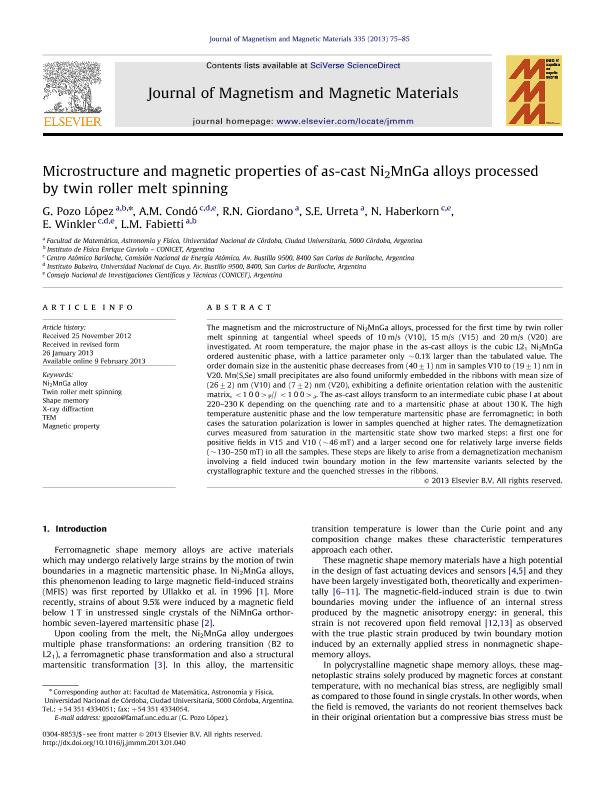Mostrar el registro sencillo del ítem
dc.contributor.author
Pozo Lopez, Gabriela del Valle

dc.contributor.author
Condo, Adriana Maria

dc.contributor.author
Giordano, Rafael Nicolás

dc.contributor.author
Urreta, Silvia Elena

dc.contributor.author
Haberkorn, Nestor Fabian

dc.contributor.author
Winkler, Elin Lilian

dc.contributor.author
Fabietti, Luis Maria Rodolfo

dc.date.available
2020-04-17T20:49:33Z
dc.date.issued
2013-02
dc.identifier.citation
Pozo Lopez, Gabriela del Valle; Condo, Adriana Maria; Giordano, Rafael Nicolás; Urreta, Silvia Elena; Haberkorn, Nestor Fabian; et al.; Microstructure and magnetic properties of as-cast Ni2MnGa alloys processed by twin roller melt spinning
; Elsevier Science; Journal of Magnetism and Magnetic Materials; 335; 2-2013; 75-85
dc.identifier.issn
0304-8853
dc.identifier.uri
http://hdl.handle.net/11336/102989
dc.description.abstract
The magnetism and the microstructure of Ni2MnGa alloys, processed by the first time by twin roller melt spinning at tangential wheel speeds of 10 m/s (V10), 15 m/s (V15) and 20 m/s (V20) are investigated. At room temperature, the major phase in the as-cast alloys is the cubic L21 Ni2MnGa ordered austenitic phase, with a lattice parameter only ~0.1% larger than the tabulated value. The order domain size in the austenitic phase decreases from (40±1) nm in samples V10 to (19±1) nm in V20. Mn(S,Se) small precipitates are also found uniformly embedded in the ribbons with mean size of (26±2) nm (V10) and (7±2) nm (V20), exhibiting a definite orientation relation with the austenitic matrix, <100>P // <100>a. The as-cast alloys transform to an intermediate cubic phase I at about 220K-230K depending on the quenching rate and to a martensitic phase at about 130K. The high temperature austenitic phase and the low temperature martensitic phase are ferromagnetic; in both cases the saturation polarization is lower in samples quenched at higher rates. The demagnetization curves measured from saturation in the martensitic state show two marked steps: a first one for positive fields in V15 and V10 (~46 mT) and a larger second one for relatively large inverse fields (~130-250 mT) in all the samples. These steps are likely to arise from a demagnetization mechanism involving a field induced twin boundary motion in the few martensite variants selected by the crystallographic texture and the quenched stresses in the ribbons.
dc.format
application/pdf
dc.language.iso
eng
dc.publisher
Elsevier Science

dc.rights
info:eu-repo/semantics/openAccess
dc.rights.uri
https://creativecommons.org/licenses/by-nc-sa/2.5/ar/
dc.subject
NI2MNGA ALLOY
dc.subject
TWIN ROLLER MELT SPINNING
dc.subject
SHAPE MEMORY
dc.subject
X-RAY DIFFRACTION
dc.subject
TEM
dc.subject
MAGNETIC PROPERTY
dc.subject.classification
Física de los Materiales Condensados

dc.subject.classification
Ciencias Físicas

dc.subject.classification
CIENCIAS NATURALES Y EXACTAS

dc.title
Microstructure and magnetic properties of as-cast Ni2MnGa alloys processed by twin roller melt spinning
dc.type
info:eu-repo/semantics/article
dc.type
info:ar-repo/semantics/artículo
dc.type
info:eu-repo/semantics/publishedVersion
dc.date.updated
2020-03-16T20:01:02Z
dc.journal.volume
335
dc.journal.pagination
75-85
dc.journal.pais
Países Bajos

dc.journal.ciudad
Amsterdam
dc.description.fil
Fil: Pozo Lopez, Gabriela del Valle. Consejo Nacional de Investigaciones Científicas y Técnicas. Centro Científico Tecnológico Conicet - Córdoba. Instituto de Física Enrique Gaviola. Universidad Nacional de Córdoba. Instituto de Física Enrique Gaviola; Argentina
dc.description.fil
Fil: Condo, Adriana Maria. Consejo Nacional de Investigaciones Científicas y Técnicas; Argentina. Comision Nacional de Energía Atómica. Gerencia de Área Investigaciones y Aplicaciones no Nucleares. Gerencia de Física (Centro Atómico Bariloche). División Física de Metales; Argentina
dc.description.fil
Fil: Giordano, Rafael Nicolás. Universidad Nacional de Córdoba. Facultad de Matemática, Astronomía y Física; Argentina
dc.description.fil
Fil: Urreta, Silvia Elena. Consejo Nacional de Investigaciones Científicas y Técnicas; Argentina. Universidad Nacional de Córdoba. Facultad de Matemática, Astronomía y Física; Argentina
dc.description.fil
Fil: Haberkorn, Nestor Fabian. Comision Nacional de Energía Atómica. Gerencia de Área Investigaciones y Aplicaciones no Nucleares. Gerencia de Física (Centro Atómico Bariloche). División Física de Metales; Argentina. Consejo Nacional de Investigaciones Científicas y Técnicas; Argentina
dc.description.fil
Fil: Winkler, Elin Lilian. Consejo Nacional de Investigaciones Científicas y Técnicas; Argentina. Comision Nacional de Energía Atómica. Gerencia de Área Investigaciones y Aplicaciones no Nucleares. Gerencia de Física (Centro Atómico Bariloche). División Resonancias Magnéticas; Argentina
dc.description.fil
Fil: Fabietti, Luis Maria Rodolfo. Consejo Nacional de Investigaciones Científicas y Técnicas. Centro Científico Tecnológico Conicet - Córdoba. Instituto de Física Enrique Gaviola. Universidad Nacional de Córdoba. Instituto de Física Enrique Gaviola; Argentina. Universidad Nacional de Córdoba. Facultad de Matemática, Astronomía y Física; Argentina
dc.journal.title
Journal of Magnetism and Magnetic Materials

dc.relation.alternativeid
info:eu-repo/semantics/altIdentifier/doi/http://dx.doi.org/10.1016/j.jmmm.2013.01.040
dc.relation.alternativeid
info:eu-repo/semantics/altIdentifier/url/https://www.sciencedirect.com/science/article/abs/pii/S030488531300067X
Archivos asociados
